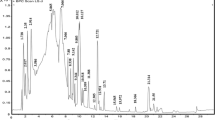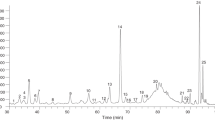Abstract
Liquorice has being used as a folk medicine for pharmacological activities in China. The phytochemicals and antioxidant activity of liquorice extract were investigated, total phenolics (TP) and total flavonoids (TF) contents were determined, and the antioxidant activity of different fractions from the extract was evaluated by scavenging free radicals (ABTS·+, DPPH· and ONOO−). On-line HPLC–ABTS·+ and HPLC–ESI–MS/MS analysis were applied to screen and identify free radical scavengers of liquorice extract. The results indicated that ethyl acetate and n-butanol fractions of the extract contained higher contents of TP and TF and exhibited stronger antioxidant activities. Thirteen compounds in the extract were identified as glycyrrhizic acid, liquorice-saponin G2, liquiritin, licuraside, ononin, glycycoumarin, isoglycyrol, liquiritin apioside, liquorice-glycoside A, liquorice-glycoside B, licoric-saponin A3, isoliquiritin apioside and isolicoflavonol, in which ten compounds were free radical scavengers. In addition, glycyrrhizic acid, ononin and liquiritin were quantitatively analyzed. These findings revealed that liquorice extract had potential antioxidant activity and could be utilized as a nutraceutical resource.
Graphical Abstract







Similar content being viewed by others
References
Zhang Q, Ye M (2009) Chemical analysis of the Chinese herbal medicine Gan-Cao (licorice). J Chromatogr A 1216:1954–1969
Chinese Pharmacopeia Commission (2005) Pharmacopeia of People’s Republic. Chemical Industry Press, Beijing (in Chinese)
Niu GG, Xie YC, Lou JF, Liu HZ (2005) Isolation and purification of glycyrrhizic acid with solvent extraction. Sep Purif Technol 44:189–196
Chen L, Tang YP, Chen MJ, Deng HS, Yan XP, Wu DK (2010) Chemical correlation between Gegen Qinlian dispensing granule and its four raw herbs by LC fingerprint. Phytomedicine 17:100–107
Shen S, Chang Z, Liu J, Sun X, Hu X, Liu H (2007) Separation of glycyrrhizic acid and liquiritin from Glycyrrhiza uralensis Fisch extract by three-liquid-phase extraction systems. Sep Purif Technol 53:216–223
Kalaiarasi P, Kaviarasan K, Pugalendi KV (2009) Hypolipidemic activity of 18β-glycyrrhetinic acid on streptozotocin-induced diabetic rats. Eur J Pharmacol 612:93–97
Fu Y, Chen J, Li YJ, Zheng YF, Li P (2013) Antioxidant and anti-inflammatory activities of six flavonoids separated from licorice. Food Chem 141:1063–1071
Li W, Asada Y, Yoshikawa T (2000) Flavonoid constituents from Glycyrrhiza glabra hairy root cultures. Phytochemistry 55:447–456
Xie YC, Dong XW, Wu XM, Yan XF, Xie QM (2009) Inhibitory effects of flavonoids extracted from licorice on lipopolysaccharide-induced acute pulmonary inflammation in mice. Int Immunopharmacol 9:194–200
Lou ZC, Qin B (1995) Species systematization and quality evaluation of commonly used Chinese traditional drugs. North-China Edition, Beijing
Squadrito GL, Pryor WA (1998) Oxidative chemistry of nitric oxide: the roles of superoxide, peroxynitrite, and carbon dioxide. Free Radic Biol Med 25:392–403
Rodrigues E, Mariutti LR, Mercadante AZ (2013) Carotenoids and phenolic compounds from Solanum sessiliflorum, an unexploited amazonian fruit, and their scavenging capacities against reactive oxygen and nitrogen species. J Agric Food Chem 61:3022–3029
Rajendran M, Manisankar P, Gandhidasan R, Murugesan R (2004) Free radicals scavenging efficiency of a few naturally occurring flavonoids: a comparative study. J Agric Food Chem 52:7389–7394
Niederländer HA, van Beek TA, Bartasiute A, Koleva II (2008) Antioxidant activity assays on-line with liquid chromatography. J Chromatogr A 1210:121–134
He L, Xu HG, Liu X, He WH, Yuan F, Hou ZQ, Gao YX (2011) Identification of phenolic compounds from pomegranate (Punica granatum L.) seed residues and investigation into their antioxidant capacities by HPLC–ABTS+ assay. Food Res Int 44:1161–1167
He WH, Liu X, Xu HG, Gong Y, Yuan F, Gao YX (2010) On-line HPLC–ABTS screening and HPLC–DAD–MS/MS identification of free radical scavengers in Gardenia (Gardenia jasminoides E.) fruit extracts. Food Chem 123:521–528
Gong Y, Liu X, He WH, Xu HG, Yuan F, Gao YX (2012) Investigation into the antioxidant activity and chemical composition of alcoholic extracts from defatted marigold (Tagetes erecta L.) residue. Fitoterapia 83:481–489
Fang N, Yu S, Prior RL (2002) LC/MS/MS characterization of phenolic constituents in dried plums. J Agric Food Chem 50:3579–3585
Sun C, Xie YC, Liu HZ (2007) Microwave-assisted micellar extraction and determination of glycyrrhizic acid and liquiritin in licorice root by HPLC. J Chin Inst Chem Eng, 15:474–477
Charpe TW, Rathod VK (2012) Extraction of glycyrrhizic acid from licorice root using ultrasound: process intensification studies. Chem Eng Process 54:37–41
Baek JY, Lee JM, Lee SC (2008) Extraction of nutraceutical compounds from licorice roots with subcritical water. Sep Purif Technol 63:661–664
Eng ATW, Heng MY, Ong ES (2007) Evaluation of surfactant assisted pressurized liquid extraction for the determination of glycyrrhizin and ephedrine in medicinal plants. Anal Chim Acta 583:289–295
Sun C, Xie YC, Tian QL, Liu HZ (2007) Cloud point extraction of glycyrrhizic acid from licorice root. Sep Sci Technol 14:3259–3270
Li XQ, Guo RL, Zhang XP, Li XY (2012) Extraction of glabridin using imidazolium-based ionic liquids. Sep Purif Technol 88:146–150
Asan-Ozusaglam M, Karakoca A (2014) Evaluation of biological activity and antioxidant capacity of Turkish licorice root extracts. Rom Biotechnol Lett 19:8994–9005
Tohma HS, Gulçin I (2010) Antioxidant and radical scavenging activity of aerial parts and roots of Turkish liquorice (Glycyrrhiza glabra L.). Int J Food Prop 13:657–671
Gong Y, Hou ZQ, Gao YX, Xue Y, Liu X, Liu GM (2012) Optimization of extraction parameters of bioactive components from defatted marigold (Tagetes erecta L.) residue using response surface methodology. Food Bioprod Process 90:9–16
Tsuda T, Kato Y, Osawa T (2000) Mechanism for the peroxynitrite scavenging activity by anthocyanins. FEBS Lett 484:207–210
Rodrigues E, Mariutti LR, Mercadante AZ (2012) Scavenging capacity of marine carotenoids against reactive oxygen and nitrogen species in a membrane-mimicking system. Mar Drugs 10:1784–1798
Kooy NW, Royall JA, Ischiropoulos H, Beckman JS (1994) Peroxynitrite-mediated oxidation of dihydrorhodamine 123. Free Radical Biol Med 16:149–156
Gomes A, Fernandes E, Silva A, Santos CM, Pinto DC, Cavaleiro JA, Lima JL (2007) 2-Styrylchromones: novel strong scavengers of reactive oxygen and nitrogen species. Bioorg Med Chem 15:6027–6036
Wu JH, Huang CY, Tung YT, Chang ST (2007) Online RP-HPLC–DPPH screening method for detection of radical-scavenging phytochemicals from flowers of Acacia confusa. J Agric Food Chem 56:328–332
Aktumsek A, Çakmak YS, Duran A (2012) Studies on antioxidant activity, volatile compound and fatty acid composition of different parts of Glycyrrhiza echinata L. EXCLI J 11:178–187
Pratibha N, Sushma D, Gupta Rajinder K (2012) Screening for Antioxidant and Antibacterial potential of common medicinal plants in the treatment of Acne. Int J Drug Dev Res 4:65–71
Li X, Chen W, Chen D (2013) Protective effect against hydroxyl-induced DNA damage and antioxidant activity of Radix Glycyrrhizae (Liquorice Root). Adv Pharm Bull 3:167–173
Gawron-Gzella A, Dudek-Makuch M, Matławska I (2012) DPPH radical scavenging activity and phenolic compound content in different leaf extracts from selected blackberry species. Acta Biol Crac Ser Bot 54:32–38
Kim HJ, Seo JY, Suh HJ, Lim SS, Kim J (2012) Antioxidant activities of licorice-derived prenylflavonoids. Nutr Res Pract 6:491–498
Rice-Evans CA, Miller NJ, Paganga G (1996) Structure-antioxidant activity relationships of flavonoids and phenolic acids. Free Radic Biol Med 20:933–956
Gülçin Ý, Elias R, Gepdiremen A, Boyer L, Köksal E (2007) A comparative study on the antioxidant activity of fringe tree (Chionanthus virginicus L.) extracts. Afr J Biotechnol 6:234–237
Hyun SK, Jung HA, Chung HY, Choi JS (2006) In vitro peroxynitrite scavenging activity of 6-hydroxykynurenic acid and other flavonoids from Gingko biloba yellow leaves. Arch Pharm Res 29:1074–1079
Choi JS, Chung HY, Kang SS, Jung MJ, Kim JW, No JK, Jung HA (2002) The structure–activity relationship of flavonoids as scavengers of peroxynitrite. Phytother Res 16:232–235
Zhu XM, Di YT, Peng SL, Wang MK, Ding LS (2003) Chemical constituents from root of Glycyrrhiza uralensis. Chin Tradit Herb Drugs 34:198–200
Su ZH, Zou GA, Preiss A, Zhang HW, Zou ZM (2010) Online identification of the antioxidant constituents of traditional Chinese medicine formula Chaihu-Shu-Gan-San by LC–LTQ-Orbitrap mass spectrometry and microplate spectrophotometer. J Pharm Biomed 53:454–461
Liu Y, Yang J, Cai Z (2006) Chemical investigation on Sijunzi decoction and its two major herbsPanax ginseng and Glycyrrhizauralensis by LC/MS/MS. J pharm Biomed 41:1642–1647
Man S, Guo S, Gao W, Wang J, Zhang L, Li X (2013) Identification of metabolic profiling of cell culture of licorice compared with its native one. Anal Bioanal Chem 405:3321–3329
Kitagawa I, Chen WZ, Taniyama T, Harada E, Hori K, Kobayashi MB, Ren J (1998) Quantitative determination of constituents in various licorice roots by means of high performance liquid chromatography. Yakugaku Zasshi 118:519
Wang Y, Kong L, Lei X, Hu L, Zou H, Welbeck E, Wang Z (2009) Comprehensive two-dimensional high-performance liquid chromatography system with immobilized liposome chromatography column and reversed-phase column for separation of complex traditional Chinese medicine Longdan Xiegan Decoction. J Chromatogr A 1216:2185–2191
Wang J, Wang D, Yu J, Liu C, Li L, Zhang Y (2013) Isolation of liquiritigenin-4′-apiosyl-glucoside and liquiritin from the root of Glycyrrhiza uralensis by high-performance centrifugal partition chromatography. J Chromatogr Sci 52(4):310–314
Fu B, Li H, Wang X, Lee FS, Cui S (2005) Isolation and identification of flavonoids in licorice and a study of their inhibitory effects on tyrosinase. J Agric Food Chem 53:7408–7414
Zheng X, Shi P, Cheng Y, Qu H (2008) Rapid analysis of a Chinese herbal prescription by liquid chromatography-time-of-flight tandem mass spectrometry. J Chromatogr A 1206:140–146
Shaw LH, Lin LC, Tsai TH (2012) HPLC–MS/MS analysis of a traditional Chinese medical formulation of Bu-Yang-Huan-Wu-Tang and Its pharmacokinetics after oral administration to rats. PLoS ONE 7:e43848
Conflict of interest
None.
Compliance with Ethics Requirements
This article does not contain any studies with human or animal subjects.
Author information
Authors and Affiliations
Corresponding author
Rights and permissions
About this article
Cite this article
Fan, R., Li, N., Jiang, X. et al. HPLC–DAD–MS/MS identification and HPLC–ABTS·+ on-line antioxidant activity evaluation of bioactive compounds in liquorice (Glycyrrhiza uralensis Fisch.) extract. Eur Food Res Technol 240, 1035–1048 (2015). https://doi.org/10.1007/s00217-014-2407-5
Received:
Revised:
Accepted:
Published:
Issue Date:
DOI: https://doi.org/10.1007/s00217-014-2407-5




